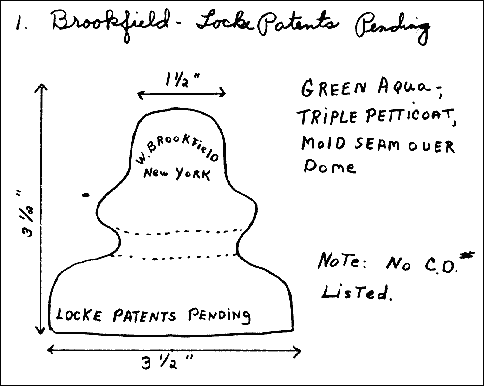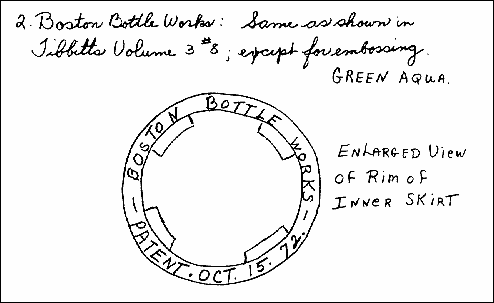Questions Answered
by N. R. Woodward
Reprinted from "INSULATORS - Crown Jewels of the Wire", January 1970, page 21
1. Question from Sam Wright. "Do you have any information on
PETTICOAT PONY front side O.V.G. CO. back side, baby signal
aqua? I found one of these and know of no one else that has one."
In regard to the question from Sam Wright, of Des Moines: I have
not seen the insulator that he is describing. Insofar as O.V.G. Co. is
concerned, I have no more data than is in the 1967 Report.
Evidently he has found a CD 160 made by that company. Their
CD 162 has PETTICOAT on the opposite half-mold: so I suppose
PETTICOAT PONY would be a logical designation for this one. I
rather think this is a rare one; this is the first report of this style in O.V.G. Co. for me.
2. No identification of B. G. M. insulators yet. I can reply with an
unqualified NO to those who say these are Brookfield products. But
it isn't much good to publish negative data; so might as well keep
quiet until something better turns up.
3. About National Insulator Company, we know very little. I have
the dates of operation, and location, which will be included in the
next Report: but this is about all. It was another of the many short-lived insulator ventures, examples of which are appearing faster
than they can be documented!

4. Don Shinner writes, "We are wondering what company produced
the insulator we have which is embossed H. Brooke's Pat. Jan. 25th 1870 on the bottom
base rim. It is listed in Tibbitts' Volume #3 under 3-9 on page 40. ( CD 127 ) We
sent the insulator to be put into his book, but didn't think to ask him
about its background. It is quite heavy and we think old. We have
just a few and know of only 4 or 5 others. We believe it to be much
scarcer than the Homer Brooke's Pat. Aug. 14, 1883. We were
offered $75.00 once and recently $100.00 for this insulator. We have
yet to find it listed on a sell or trade list. Any information you can
give us will be greatly appreciated."
Now in regard to the Don Shinner question. I can't say much about this
either! I'm not being much help at all. Up to this time I have not seen
an insulator made under the 1870 Homer Brooke press patent by
anyone except Brookfield. I had assumed that they purchased the
patent quite immediately after it was issued. In that era, the base rim
lettering was an Oakman feature: and I have not known of a
Brookfield unit lettered in this way. I have no knowledge of this one.
Upon viewing it I might be able to deduct something rather definite;
or perhaps not! But when people start talking about $100.00
valuations, I don't want to accept the responsibility of having the
insulators mailed to me--so perhaps will have a chance one day to
see one in someone's collection!

5. Now to attempt comment on the two drawings
sent by Mrs. Stecher of Rochester, N. Y.:
The W. BROOKFIELD / LOCKE PATENTS PENDING is a
complete stranger to me. ( CD 287.2 - pictured on page 22 ) As we know,
Brookfield made the Locke line. I would guess this was one of the very first. I
wouldn't venture to say what patent they had in mind; but this is not too
important. Locke insulators are notorious for listing patent dates that do not
apply to the insulators they are listed on. So far as I know, the earliest Locke
patent to be applied to a glass unit is the May 22, 1894 date covering a
two-groove transposition insulator. The Locke No. 14 was subsequently
manufactured and distributed under this patent. But that date is molded onto
many insulators that are in fact not transposition units. The LOCKE PATENTS
PENDING would have a tendency to discourage imitations of the product, even
though no patent was involved which could prohibit the production of that
particular unit. Anyway--this is another very interesting, and no doubt rare,
insulator!
The BOSTON BOTTLE WORKS / PATENT. OCT. 15. 72. is
also a valuable one. Read about the patent involved on page 10 of the 1967
Report, paragraphs 3 and 4. At the time this was written, I was not aware
that the date was molded on insulators; so I didn't specifically mention it. But
this is the 1872 patent referred to.
| 